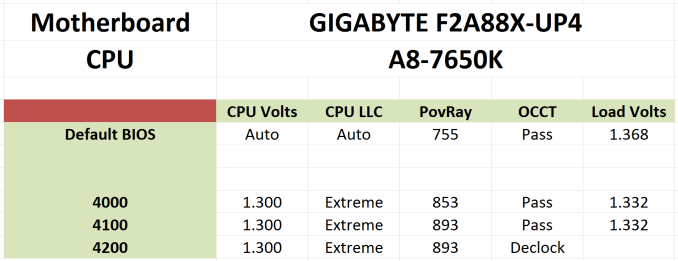The AMD A8-7650K APU Review, Also New Testing Methodology
by Ian Cutress on May 12, 2015 10:00 AM ESTTest Setup
| Test Setup | |
| Processor | AMD A8-7650K 2 Modules, 4 Threads 3.3 GHz Base, 3.7 GHz Turbo 95W, MSRP $105 |
| Motherboard | GIGABYTE F2A88X-UP4 |
| DRAM | G.Skill RipjawsZ 4x4GB DDR3-2133 9-11-10 |
| Low End GPU | Integrated ASUS R7 240 2GB DDR3 Dual Graphics with R7 240 |
| Mid Range GPU | MSI R9 285 Gaming 2GB MSI GTX 770 Lightning 2GB |
| High End GPU | MSI R9 290X Gaming LE 4GB ASUS GTX 980 Strix 4GB |
| Power Supply | OCZ 1250W Gold |
| Storage Drive | Crucial MX200 1TB |
| Operating System | Windows 7.1 64-bit, Build 7601 |
| CPU Cooler | Cooler Master Nepton 140XL CLC |
Many thanks to...
We must thank the following companies for kindly providing hardware for our test bed:
Thank you to AMD for providing us with the R9 290X 4GB GPUs.
Thank you to ASUS for providing us with GTX 980 Strix GPUs and the R7 240 DDR3 GPU.
Thank you to ASRock and ASUS for providing us with some IO testing kit.
Thank you to Cooler Master for providing us with Nepton 140XL CLCs.
Thank you to Corsair for providing us with an AX1200i PSU.
Thank you to Crucial for providing us with MX200 SSDs.
Thank you to G.Skill and Corsair for providing us with memory.
Thank you to MSI for providing us with the GTX 770 Lightning GPUs.
Thank you to OCZ for providing us with PSUs.
Thank you to Rosewill for providing us with PSUs and RK-9100 keyboards.
AMD A8-7650K Overclocking
Methodology
Our standard overclocking methodology is as follows. We select the automatic overclock options and test for stability with PovRay and OCCT to simulate high-end workloads. These stability tests aim to catch any immediate causes for memory or CPU errors.
For manual overclocks, based on the information gathered from previous testing, starts off at a nominal voltage and CPU multiplier, and the multiplier is increased until the stability tests are failed. The CPU voltage is increased gradually until the stability tests are passed, and the process repeated until the motherboard reduces the multiplier automatically (due to safety protocol) or the CPU temperature reaches a stupidly high level (100ºC+). Our test bed is not in a case, which should push overclocks higher with fresher (cooler) air.
Overclock Results
The base frequency of the A8-7650K goes up to 3.7 GHz in the highest turbo mode, and we were able to jump right into 4.0 GHz without much problem. That being said, our sample did not move much above that, giving 4.1 GHz but at 4.2 GHz we noticed that the CPU frequency would decrease during sustained workloads, resulting in a zero performance increase overall.











177 Comments
View All Comments
Sejong - Tuesday, May 12, 2015 - link
No comments. That just states AMD`s current position.bumble12 - Tuesday, May 12, 2015 - link
Well, if you post a minute or two after the review goes live, what might you expect exactly?YuLeven - Tuesday, May 12, 2015 - link
I think you'll find that he said "no comments" as in "no comments about AMD's poor performance", not as in "there aren't comments on this review" pal.anandreader106 - Tuesday, May 12, 2015 - link
....not sure if serious....or trolling....DevilSlayerWizard - Tuesday, May 12, 2015 - link
I would prefer if AMD made a quad core Zen with ''atleast'' 1024 GCN cores, whatever memory subsystem needed to feed the chip including RAM and motherboard for less than 500$ in 2016. Pretty reasonable if you ask me.barleyguy - Tuesday, May 12, 2015 - link
The PS4 processor, which AMD makes, is an R9-280 with an 8 core CPU. The problem is that it would be memory limited quite badly on a PC motherboard. In the PS4 it's paired with very fast memory.Possibly when AMD goes to DDR4 their APUs will start to shine, and they'll have the memory bandwidth to go wider on the GPU.
extide - Tuesday, May 12, 2015 - link
No, it's not. It is roughly between an R7 265 and R9 270 -- not anywhere near an R9 280.ravyne - Tuesday, May 12, 2015 - link
Its not a 280 -- Its got 20 GPU clusters only for 1280 shader lanes, two clusters are there for yield purposes and 4 more are dedicated to compute tasks. It has only 896 shaders dedicated to graphics, and and 256 for compute (though some engines leverage compute during rendering, so the line is a bit fuzzy). The PS4 has a 512bit memory bus, which is really wide for the GPU power, but its also feeding CPU compute. Its got 8 ACES like the 290/X.The 280 fully unlocked has 32 clusters for 2048 shaders. A 280/X has a 256bit GDDR5 bus, and only 2 ACES.
What's in the PS4 is also custom-extended beyond any retail GPU, but the closest thing would be like a Hawaii (290/X) or Tonga (285), but cut down to 18 clusters.
Revdarian - Wednesday, May 13, 2015 - link
The ps4 doesn't have 256 shaders for compute only, it has 1280 shaders total and that is it, how you decide to divide the workload for your engine is up to you, what you are thinking of was totally taken out of the context of it being an example of how to use the tools provided to the developers.nikaldro - Saturday, May 16, 2015 - link
Ps4 has 1152